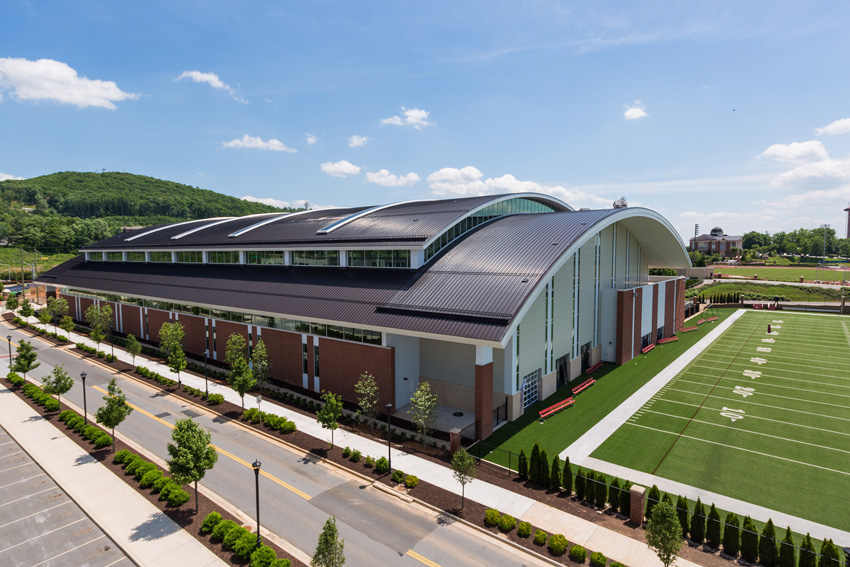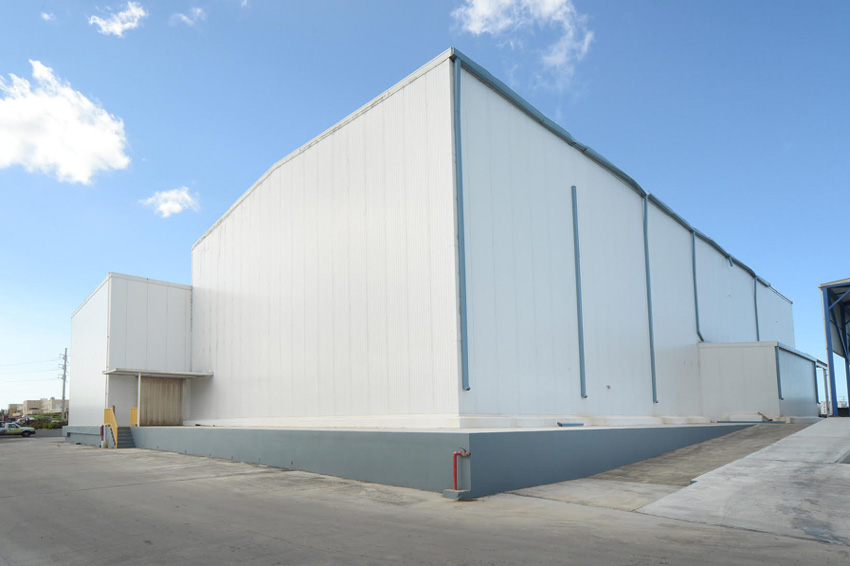Show Your Mettle
Designing with metal brings durability, energy savings, and cost efficiency together
![]() Continuing Education
Continuing Education
Use the following learning objectives to focus your study while reading this month’s Continuing Education article.
Learning Objectives - After reading this article, you will be able to:
- Apply principles of building-related costs and life-cycle cost analysis (LCCA) to make the best material selections for durability and cost effectiveness.
- Discuss the versatility of metal as a building material and how its attributes contribute to sustainability and resilience.
- Compare and contrast advantages of building materials, both during initial construction and through a building’s life cycle.
- Describe the impact that metal’s disaster resistance has for the building’s durability.
This course is part of the Metal Architecture Academy
In October 2018, The New York Times published a haunting photo and article chronicling the devastation left in Florida’s Panhandle in the wake of Hurricane Michael. Alone among the destruction stood an elevated house built out of reinforced concrete walls with a metal roof. When interviewed, Dr. Lackey, one of the owners of the surviving structure, told The Times, “We were thinking that we need to build a house that would survive for generations.” Such forethought led to the construction of a home that persisted through the storm’s ferocity, when none of its neighbors did.

Photo: Johnny Milano/The New York Times/Redux
Protected with a metal roof, this elevated house in Mexico Beach, Florida, came out of Hurricane Michael almost unscathed.
What type of analysis is entailed to allow a building to stand the tests of time? Obviously, before embarking on any construction project, it is vital to count costs to create an accurate budget. But that begs the question, “Are we counting the right costs?” Initial costs account only for product price tags: a comprehensive accounting must also weigh product life, environmental impacts, resilience, and durability.
“When we build, let us think that we build forever,” advised John Ruskin in The Seven Lamps of Architecture, 1849.
Calculating Building Costs with the Big Picture in Mind
When calculating the true cost of any potential building material, accounting for the price of the materials and labor for installation are obvious pieces of the equation. However, other more subtle parameters radically impact material math. Attributes like lifespan and resilience should also play a major role in decision-making.
According to Sieglinde Fuller of the National Institute of Standards and Technology (NIST), building-related costs usually fall into the following categories:
- Initial costs: purchase, acquisition, and construction costs;
- Fuel costs;
- Operation, maintenance, and repair costs;
- Replacement costs;
- Residual values: resale or salvage values, or disposal costs;
- Finance charges: loan interest payments; and
- Nonmonetary benefits or costs.

Photo courtesy of 3A Composites USA
THE CONNOR GROUP HEADQUARTERS, MIAMISBURG, OHIO
Planning a building means searching for the best material combination to support performance, durability, and budget goals.
Lowest life-cycle cost (LCC) is the most straightforward and easy-to-interpret measure of economic evaluation. Other commonly used measures are net savings (or net benefits), savings-to-investment ratio (or savings benefit-to-cost ratio), internal rate of return, and payback period. Building economists, certified value specialists, cost engineers, architects, quantity surveyors, operations researchers, and others might use any or several of these techniques to evaluate a project. The approach to making cost-effective choices for building-related projects can be quite similar whether it is called cost estimating, value engineering, or economic analysis.1
Life-cycle cost analysis (LCCA) is a method for assessing the total cost of facility ownership. It takes into account all costs of acquiring, owning, and disposing of a building or building system. LCCA is especially useful when comparing project alternatives that fulfill the same performance requirements but differ with respect to initial costs and operating costs. For example, applying LCCA determines whether the incorporation of a high-performance HVAC or glazing system, which may increase initial cost but result in dramatically reduced operating and maintenance costs, is cost-effective or not.
Environmental product declarations (EPDs) are another tool for the design professional weighing material decisions. EPDs allow for confidence when selecting building materials and designing to develop more energy-efficient and environmentally responsible buildings. EPDs are third-party verified documents that report environmental data of products based on life-cycle assessment (LCA), in accordance with the international standard ISO 14025 (Type III Environmental Declarations). EPDs are structured like executive summaries and display the environmental impact of products in a number of categories.
Applying LCCA and EPDs offers a vital path to discovering true costs.
Examining Full Costs: Metal as a Commercial Design Material
Throughout history, metal has been used on buildings to shelter inhabitants and protect the structure from the elements. Today, metal’s inherent qualities of strength, lighter weight, and durability are complemented by the visual beauty of modern architectural aesthetics.

Photo courtesy of All Weather Insulated Panels
WESTERN DISTRIBUTION SERVICES, SEATTLE
Though metal is a historical building material, its qualities and aesthetic are a perfect match for contemporary design.
Metal can be found across the entire modern enclosure, from roof to walls. Types of metal roof and wall systems include:
- Low-slope roofs: Used on roof pitches from 1⁄4:12 to 3:12, a low-slope roof consists of interlocking panels across the roof and is applied directly over bar joists or purlins. It is generally made from steel or possibly aluminum.
- Steep-slope roofs: Used on roof pitches of 3:12 or greater, structural steep-slope roofs are generally applied over open framing but can also be installed over a solid deck. Architectural steel-slope roofs typically require a solid deck. This roof can be made from steel, aluminum, copper, or zinc.
- Pre-formed wall panels: Combining economy, service, and design benefits, profiles are roll-formed at the plant in various shapes and shipped ready to install. These panels are made from steel, aluminum, copper, or zinc.
- Insulated metal panels: Insulated metal panels (IMPs) combine thermal performance and aesthetics. IMPs are made by injecting foam insulating material between two metal face sheets, typically steel or aluminum. The injected foam expands to fill the cavity and then solidifies to create a solid, monolithic panel. IMPs offer the highest insulating value per inch of all wall-insulating products. In commercial applications, a 2-inch-thick panel meets most buildings’ insulating requirements.
- Metal composite wall panels: Combining panel flatness and beauty, composite panels are formed by bonding two metal skins to a plastic core that has been placed between them, creating a thin “sandwich” sheet. Composite walls are made from aluminum, zinc, copper, stainless steel, and titanium.
- Natural metal: Highly malleable metals like copper, zinc, or aluminum are easily formed into shapes. Extremely durable with exceptionally long service lives, natural metal panels are often installed uncoated to capitalize on their natural beauty.
Metal is a versatile building material, boasting both historical credentials and modern aesthetics. To earn the right to rise to the top as the material of choice, however, metal must also demonstrate cost efficiency, durability, and minimal environmental impact.
Weighing the Cost of Metal: Initial Advantages
As soon as it arrives on-site, metal is already helping keep costs in check. Though initially higher in price to purchase than some entry-level materials, metal roof and wall systems can help lower construction, operating, maintenance, and LCCs.
Metal lends itself to modular construction and its accompanying expedited construction benefits. Nothing quite compares to witnessing a building take shape within a matter of weeks, along with concomitant lower costs and speed to occupancy. Compared to other materials such as brick or concrete, metal roofing and walls are relatively lightweight, providing less of an impact on the load-bearing foundations. Installation is much quicker than with other heavier and bulkier wall materials, resulting in significant labor and scheduling savings, and potentially reducing structural framing requirements. This can reduce labor costs, minimize construction delays, and get the building closed-in quickly.
In addition, metal roofs and walls can be erected even in inclement weather conditions, allowing construction to proceed regardless of the season and enabling contractors to move forward with interior work.
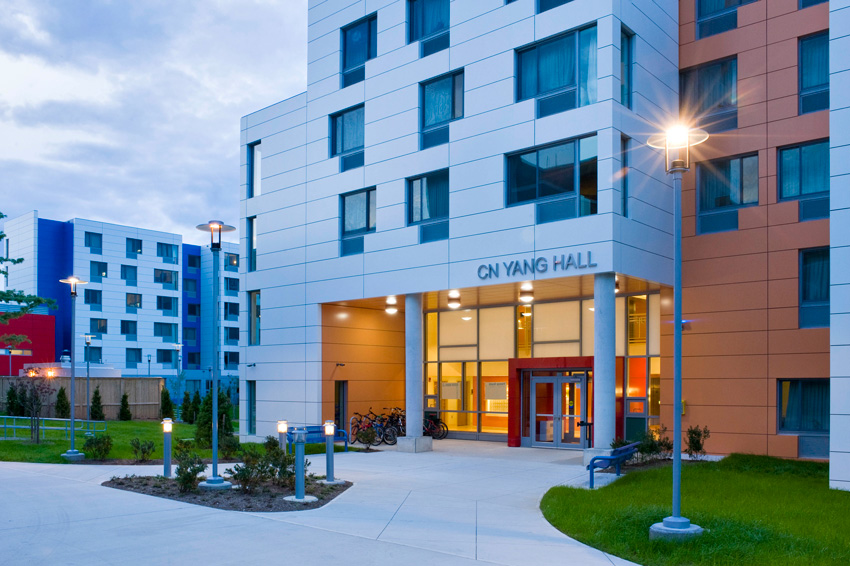
Photo courtesy of 3A Composites USA Inc.
STONY BROOK UNIVERSITY NOBEL HALLS
Metal offers a suite of benefits that deploy as soon as it arrives on-site. It is quicker to install than other materials and is not subject to weather delays, allowing for projects to stay on schedule.
Where composite or IMP products are selected, building teams can cash in on additional construction benefits. IMPs install in one step, creating a finished wall, insulation, and liner, thereby allowing the construction team to dry-in the building faster than with conventional construction methods. As opposed to conventional stud construction, for example, which requires contractors to wait for multiple trades to install sheathing, building wrap, and insulation prior to interior finishing, IMPs offer a one-shot building enclosure installation, significantly shortening project schedules and construction expenses, states Don Olsen, vice president of operations with the Hartland, Wisconsin-based A/E firm ESI Design Services.
Under research conducted by the Metal Construction Association (MCA) and published in its Selection Guide for Insulated Metal Panels, IMPs can be erected at a rate of up to 5,000 square feet per 8-hour shift by a four-person crew on an industrial project, and up to 1,100 square feet per 8-hour shift by a four-person crew on an architectural project.
Unlike some cladding materials, IMPs can be installed year round, even in adverse weather conditions.
“One of the major advantages of IMPs is that they typically do not need extensive backup walls or support system assemblies, while still meeting code requirements,” adds Deniz Ferendeci, AIA, LEED AP BD+C, director of building services, Dyer Brown, Boston. “The majority of these products are self-supporting, which means installation is faster and less complicated.” IMPs perform triple duty as air and water barriers with insulation, helping them survive the value-engineering process.
Speed of build is a major advantage of metal. Building with metal takes less time to construct, and less time equals lower costs.
Additionally, using metal reaps immediate dividends when it comes to building insurance. The cost of risk insurance for metal buildings during construction is half that of other building materials because there is less risk of fire damage. Insurance may also be less after completion.
Weighing the Cost of Metal: Long-Term Advantages
Not only does metal deliver cost efficiencies and advantages when first on the job site, but those benefits also extend throughout the building’s life. As a highly durable, long-lasting material, metal roofs and panels deliver an excellent return on investment.
In a whole building LCA study by Houston-based Walter P. Moore Associates on behalf of the Metal Building Manufacturers Association, the environmental impact of metal buildings was found to be lower in case studies comparing structural and envelope materials to load-bearing concrete, masonry, tilt-up, and steel-framed construction within the same basic building footprint. The study concluded that in buildings where metal is typically most economical, LCA performance is also better, with the least embodied building material impact.
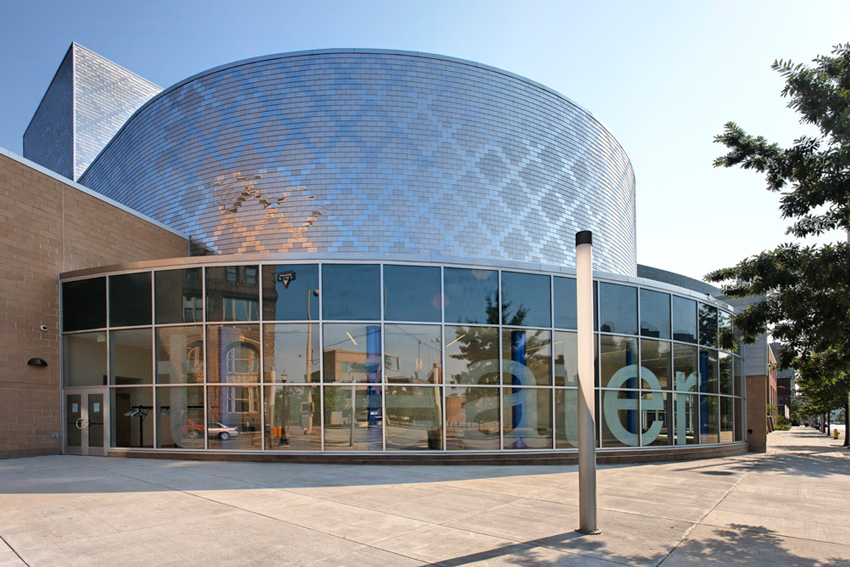
Photo courtesy of RHEINZINK America Inc.
The zinc used here at this Cincinnati Public Schools building offers extreme durability, with an exceptionally long service life and minimal maintenance.
Durability
Metal earns a favorable LCA due to a variety of attributes. First, metal roofs and walls are extremely durable, with long service lives. This lowers demand for raw materials to produce replacement systems. The Environmental Protection Agency (EPA) ranks metal roofing as one of the most eco-friendly roofing solutions in terms of waste reduction.2 Average expected service life for a metal roof is 60 years versus 23 years for a built-up and 20 years for single-ply. Expected LCCs run around 30 cents per square foot per year for commercial metal roofs; built-ups tally 37 cents per square foot per year, and single-ply comes in at 57 cents annually. Analyzed in a different way, percent of total installed cost spent on maintenance was 3.5 percent for metal, 19 percent for built up and 28.5 percent for single-ply. Therefore, metal roofs are a highly cost-effective roofing system. More recently, field inspections of 14 low-slope standing-seam roofs in place in the United States with up to 35 years of service have shown that the product continues to perform well in a wide range of environments, and that the current 25-year warranty period clearly underestimates the actual service life of a 55 percent Al-Zn alloy-coated steel-standing seam roof.3
Beyond its natural durability, metal keeps maintenance to a minimum. Where unpainted natural metals are used, the product is virtually maintenance free. Patinas protect the surface. Where high-performance paints and coatings are applied to protect metal panels or for aesthetics, the finishes are formulated to last up to 25 years or more, helping panels to retain their original appearance while ensuring the building maintains its visual appeal.
Operating Costs
Minimal maintenance leads to minimized operating costs. Where IMPs are selected, the building experiences lower energy costs and more uniform performance. Insulation thickness is maintained between metal panels, and there are no points at which it is compressed. Not only does this preserve R-values across the panel, but tongue and groove joinery also ensures that the entire wall area is covered, with no thermal gaps.
Benefits of minimizing operating costs spill into environmental stewardship and sustainability. Reducing energy consumption and improving air quality and thermal comfort not only support a building’s bottom line, but they also help the structure comply with energy codes, reduce environmental impacts, and can contribute to LEED points.
Sustainability
Sustainability starts on-site. Shop-fabricated metal components reduce on-site labor, cycle time, and construction waste. A 2,000-square-foot residence framed in steel produces less than 2 percent leftover material, all of which can be recycled, compared to wood framing with 20 percent of its waste going to a landfill. Since metal is extremely durable with a long service life, this lowers demand for raw materials to produce replacement systems.
Metal buildings offer effective insulation, reduced air leakage, and support high-performance windows and doors. A metal roof can also be the ideal base to support solar panels. All of these factors can be used to earn LEED points.
Metal roof and wall systems are an environmentally responsible and sustainable choice for commercial buildings of all types.
Examining metal’s sustainability can start at the top. Often, the roof is the least energy-efficient building envelope component. Energy-efficient roofing makes environmental and economic sense, as heating and cooling represent major expenses in building operation. Roofs that are highly reflective and highly emissive, such as pre-painted metal, offer a roof system that significantly reduces heat gain into the building. This “cool roofing” is gaining in popularity because it can reduce cooling energy usage, help reduce peak demand during summer, and help mitigate the urban heat island effect. Cool metal roofs combine the enhanced aesthetics and durability of a metal roof with energy savings across the entire enclosure. Not only do lower roof temperatures increase the color stability of the metal roof, but they also decrease thermal expansion and contraction. For every 10 percent increase in roof reflectance, heating and cooling costs drop $0.02/square foot per year, depending on location and utility rates, according to Lawrence Berkeley National Laboratory. Additionally, metal roofs can be installed over old flat roofs, which eliminates the need to remove old roofing and conserves landfill space. Metal roofs also can be designed to create a ventilation cavity that further reduces peak heat gain. Furthermore, metal roofs are excellent rainwater catchment surfaces. Captured rainwater can be used for building or irrigation use and can contribute up to seven LEED points under Water Efficiency Credits 1, 2, and 3.
LCA
In an LCA, metal conforms to “cradle-to-cradle” standards. This term refers to design standards for creating products that model the view of natural materials as nutrients circulating in healthy, safe metabolisms. Metal meets these requirements and garners excellent environmental ratings because of its recyclability. Metal is the only known construction material that can be recycled and repurposed indefinitely. Any excess or scrap metals, particularly steel and aluminum, are readily and easily recyclable. Metal roof and wall panels are made with the highest recycled content from the most recyclable materials on earth, making them a great choice, not only for today but also for future generations to use. The high recycled content and recyclability of metals like steel, aluminum, copper, and zinc allow for metal construction products to be routinely included on listings for “green” or sustainable building materials.
The federal government and some states are mandating energy-saving requirements for buildings, or giving tax breaks or other incentives for energy-efficient and energy-saving construction products. Because recycling decreases the amount of energy required to produce metal products, recycled content is also being recognized and rewarded, making recycling an economic as well as environmental benefit.
One-hundred percent recyclable, metal walls and roofs can also be manufactured with 40 percent recycled steel. This figure is especially impressive in light of the estimated 11 million tons of asphalt shingles that end up in landfills. Metal used in typical roof and wall installations generally contains at least 25 percent recycled content.
Given this recyclability, metal can contribute to points in LEED v4 in the categories of Energy & Atmosphere, Sustainable Sites, Materials & Resources, and Construction Waste Management.
Indoor Environmental Quality
Metal components with an applied finish are shop painted, limiting any volatile organic compounds (VOCs) to the controlled environment of the factory. Metal roofs and walls are inert, with no off-gassing and no VOCs.
Daylighting and exterior views can also be easily incorporated into a metal building design to earn LEED credits.
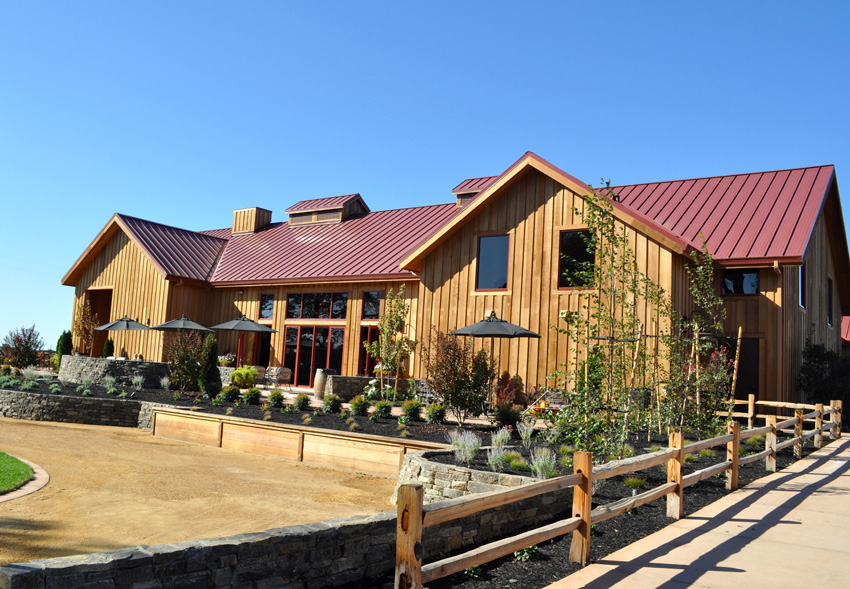
Photo courtesy of Drexel Metals Inc.
The cool roof at this Napa winery reduces cooling energy usage, helping to reduce peak demand during summer and mitigate the urban heat island effect. Cool metal roofs combine the enhanced aesthetics and durability of a metal roof with energy savings across the entire enclosure.
Cool Roofs and Walls
Cool roofs and walls are an emerging trend in codes. Roofs and walls with heat-reducing finishes can lower building energy consumption by reducing cooling loads. When effectively designed, not only does the individual building reap benefits, but it also helps to mitigate the urban heat island effect and reduce smog production.
The effectiveness of the material selected for a cool wall or roof depends on its solar reflectance and thermal emittance. The use of dark building materials in urban areas creates ambient temperatures higher than surrounding areas. Roofs with high reflectance have lower surface temperatures, which helps to reduce ambient temperatures and improve air quality. Cool metal roofing can achieve reflectance of more than 70 percent. Cool metal roofs lower energy costs by reducing cooling loads up to 40 percent, according to Oak Ridge National Laboratory.
Cool metal roofs and walls can contribute to LEED v4 points in the Energy & Atmosphere category, Optimize Energy Performance credit and Sustainable Sites category, Heat Island Reduction credit.
The benefits of selecting metal for cool roofs and walls are as durable as the material itself. A study conducted by Oak Ridge National Laboratory shows that metal roofing maintains 95 percent of its solar reflectance over its service life. This longevity is important because some codes assume that reflectivity of all roof materials degrade at the same rate. Since metal roofs shed dirt readily, its reflective performance tends to be less compromised than that of other materials. Some membrane products lost 40 percent of their solar reflectance after only three years due to dirt retention.
As more codes and standards include building envelope energy-efficiency requirements, and more labeling and rating systems are being developed for energy-efficient building-envelope products, more incentives exist to install cool metal roofs and walls to reduce energy consumption. Among the programs and certifications promoting cool walls and roofs are LEED, California Title 24, California Energy Commission, Florida White Roof Credit, Georgia Energy Code, New York Tax Incentive, Chicago Urban Island Code, Federal Energy Bill, LBNL Urban Island Group, the ORNL Building Technology Center, ASTM Committees, ASHRAE Committees, the Cool Roofing Rating Council, and Millennium Star.
Weighing the Cost of Metal: performance in the Face of Disaster
Extreme weather such as hurricanes has brought the importance of durability into the calculations for buildings. To maximize its durability and life, a building must be equipped to shield its occupants, from weather, fire, water, high winds, severe storms, and, where applicable, hurricanes and tornadoes.

Photo courtesy of Englert Inc.
The Magdalena Grand Beach Resort in Tobago was built to withstand the natural disasters prone to the island. A metal roof was selected to protect against the extreme uplift caused by hurricane-force winds.
In September 2011, Tropical Storm Lee roared into the Gulf of Mexico and wreaked havoc in states from Louisiana and Mississippi all the way up to Pennsylvania and New York. It caused severe flooding in many of those states and left deep scars on many communities in its wake.
One of those communities was the town of Owego, New York. The county seat of Tioga County, the town of just about 4,000, was hard hit by rising waters brought on by Tropical Storm Lee. The school district was smashed with particular fury. Four of the district’s buildings were completely destroyed by flooding, and others were severely damaged.
When the waters receded, the village pulled together to restore its infrastructure. “After Tropical Storm Lee hit and flood waters destroyed the area, Highland was called by the district to help assess the damage,” recalls David Degnon, senior associate with Highland Associates. “We were on-site within days of the initial flooding, and working hand in hand with the district, FEMA, the New York State Education Department, and the state of New York, we designed three new buildings to replace the four lost to the storm.”
The new facility housing the community’s elementary school was set to be built in the same place as the original, but this time it would be raised above the flood plain in accordance with U.S. Federal Emergency Management Agency (FEMA) guidelines to mitigate future potential disasters.
There were four major goals laid out from the beginning of this project. First was to create a space where students could feel safe and comfortable. Second was to design engaging spaces that extend learning beyond the classroom. Third was health and wellness, which meant maximizing daylighting and improving indoor air quality while pursuing a LEED Silver certification. And fourth was to serve the community as a symbol of healing.
The design team selected multiple horizontal metal panels with profiles that resemble residential siding. Sloped metal-panel roofing was selected to resemble the sloped roofs of the surrounding neighborhood. “We also chose flat insulated metal panels for the main entrance and at the classrooms to give the building a distinct, modern feel,” Degnon says. “The range of colors used for the metal panels were dark bronze, blue, and copper. These are all colors that occur in natural bluestone, which is another cladding material commonly used in this area.” A manufacturer’s insulated composite backup panel system provides thermal and moisture performance behind the bulk of the mixed-medium building envelope. The product features integral attachment systems for metal, terra cotta, brick, and other facade materials, making it the perfect solution for mixed-medium exteriors.
“From disaster comes opportunity. The new Owego Elementary School is a state-of-the-art, 124,000-square-foot facility that will serve the community for generations,” Degnon says. “As design professionals, we learned to keep pushing the envelope of possibilities. It is our job to design spaces that evoke emotion. I have seen that emotion on the faces of the children who occupy the school, the faculty and staff who work in the school, and the community members who have visited the school. Highland Associates feels very fortunate to have been part of such a special project.”
Metal brings multiple benefits to the table when thinking about how best to preserve a building in the face of natural disasters. Metal panels can offer completely noncombustible surfaces, superior strength, ductility, and the ability to avoid corrosion and mold.
Fire
Wildfires are called wild for a reason: they are often uncontrollable, notes the Insurance Institute for Business & Home Safety (IBHS). According to IBHS, what is controllable is the preparation undertaken through design and maintenance to protect a structure from damage and losses when a wildfire threatens. “Ultimately, the difference between survival and destruction is whether some part of the building catches on fire. There are two parts to the ignition process. The most vulnerable part of your structure is your roof. If you have a flammable roof, almost anything else you do will be of little consequence in reducing the chances that the structure will burn when a wildfire approaches. Other key risk factors include vents that can allow embers to enter the attic; fences and decks that can ignite and bring a fire right up to the building; single-pane windows that can shatter and allow flames and embers inside; and debris that collects in gutters and in various locations along the roof and wall lines.” When metal wall and roof panels are used, sparks that reach the structure will neither create a blaze nor spread flames. Designing the roof with minimal overhang can keep the structure from channeling hot air, while using fire-resistant materials for soffits, decks, and balconies further reduces the potential for fire.
Roof combustibility is described by the UL rating system, with Class A being the least combustible. IBHS advises the following checks when choosing a Class A roof covering:
Many roof coverings have a Class A rating based only on the top/external part of the roof that is exposed. Some examples include asphalt composition fiberglass shingles, steel roofs, and clay or concrete tiles.
For roofs composed of noncombustible materials like tile or metal, the gaps between covering and roof sheathing, which can occur at the edge and ridge, must be filled with either a bird stop or other material to seal the openings.
IBHS also advises that, if combustible siding is present where a lower level roof meets an upper level roof or wall, that siding material be replaced with a more fire-resistant material.
Not only do metal roofs and walls protect during wildfire events, but they can also lower insurance premiums on a daily basis because of their fire resistance. Additionally, insurance premiums can be lowered because metal does not support mold, corrode, or suffer from pest infiltration and damage.
High-Wind Events
Exceptionally high winds produce extreme uplift. This directly attacks the enclosure’s roof and its interface to the building, making strong roof and building design essential. For hurricane-prone areas, structural metal panel roof systems on open framing members and nonstructural architectural metal roof panels on solid wood sheathing with any of the product approvals found in the IBHS Fortified Commercial Standard, Appendix A, Section 5.4 are permitted, provided adjustments are made in design/allowable pressures as outlined in Section 3.1.1.3. Architectural metal panels shall be installed over continuous decking and one of the acceptable sealed roof deck underlayment options from Section 3.1.3.3.1. Approved structural metal panel roof systems on spaced supports and nonstructural architectural metal roof panels on solid wood sheathing include those approved by the following:
- Florida Product Approval (FPA);
- FM Approved;
- ICC-Evaluation Services (ICC-ES);
- Miami-Dade Approved; and
- Texas Department of Insurance (TDI).
Floods
In flood events, metal frame and panels will receive no lasting damage and are not subject to corrosion. Water infiltration will not lead to warping, mold, or other degradation of metal components.
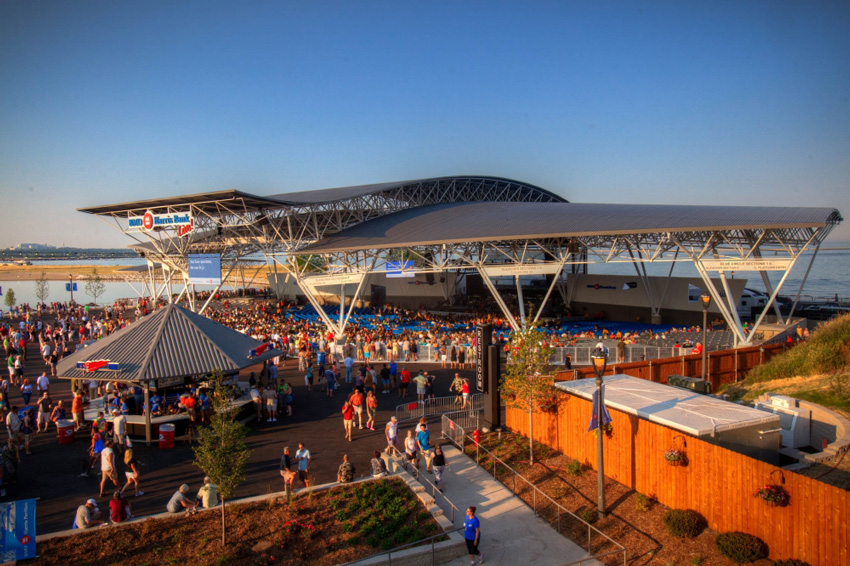
Photo courtesy of McElroy Metal
BMO HARRIS PAVILION
A unique material with unique attributes, metal shows its mettle through both short and long-term advantages, product life, environmental impacts, resilience, and durability, even in the face of disasters.
Metal Proves Its Mettle
Ultimately, design professionals are faced with determining whether the costs they are counting are the right costs. When choosing a material, does it have the right attributes to reflect the realities and demands the building faces, and has that been accounted for? Metal has found itself under the microscope and, based on a comprehensive accounting of short- and long-term advantages, product life, environmental impacts, resilience, and durability, even in the face of disasters, it has shown its mettle.
It is green. According to the MCA, “Metal building materials, with their recyclable nature, efficiency of assembly, and energy efficiency, are the logical and responsible choice for green building.”
It is cost effective. When you look at the total building costs, including costs of construction, maintenance, and insurance, metal construction is more cost effective than many other building materials. It is aesthetically pleasing, long lived, and energy efficient. When properly chosen and installed, metal roof and wall systems are attractive, long-lasting, easily maintained, cost-effective, energy-saving, and environmentally friendly building materials.
Metal is durable even in the face of nature’s fury. Building with metal is more durable and holds up better in high winds, hurricanes, and wildfires than other building systems. In short, metal has proven its mettle.
Amanda Voss, MPP, is an author, editor, and policy analyst. Writing for multiple publications, she also currently serves as the managing editor for Energy Design Update.
END NOTES
1 Whole Building Design Guide Accessed July 15, 2019.
2 Florida Department of Environmental Protection, Accessed August 12, 2019.
3 MCA Executive Summary of Report on Service Life Assessment of Low-Slope Unpainted 55% Al-Zn Alloy Coated Steel Standing Seam Metal Roof Systems. Report by: Ron Dutton, Ron Dutton Consulting Services LLC; Rob Haddock, Metal Roof Advisory Group; Chuck Howard, Metal Roof Consultants; and Scott Kriner, Metal Construction Association. Report dated 2014, and reviewed 10/18.

